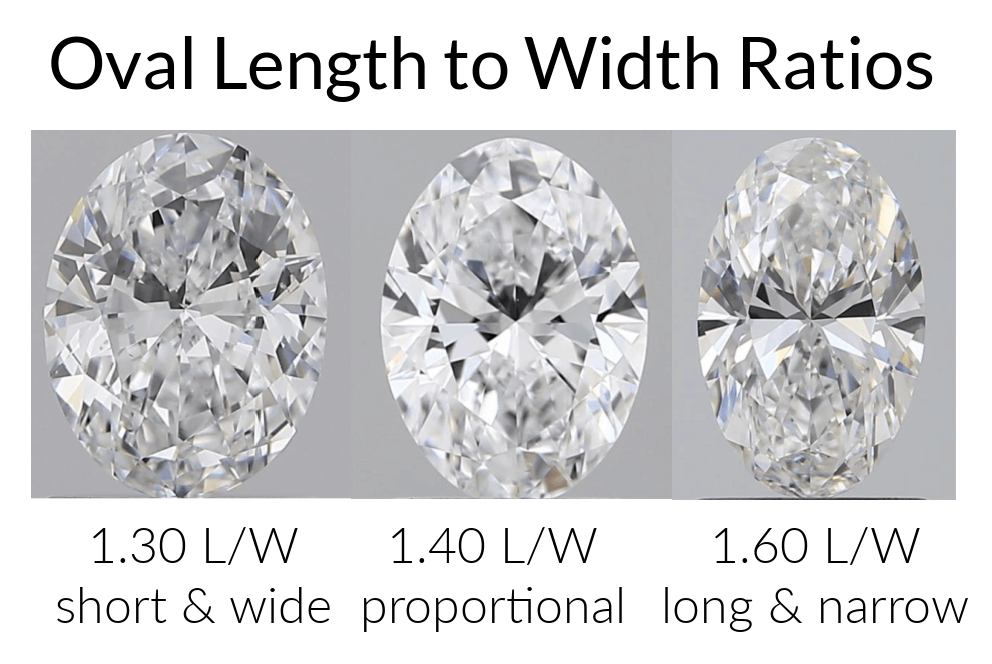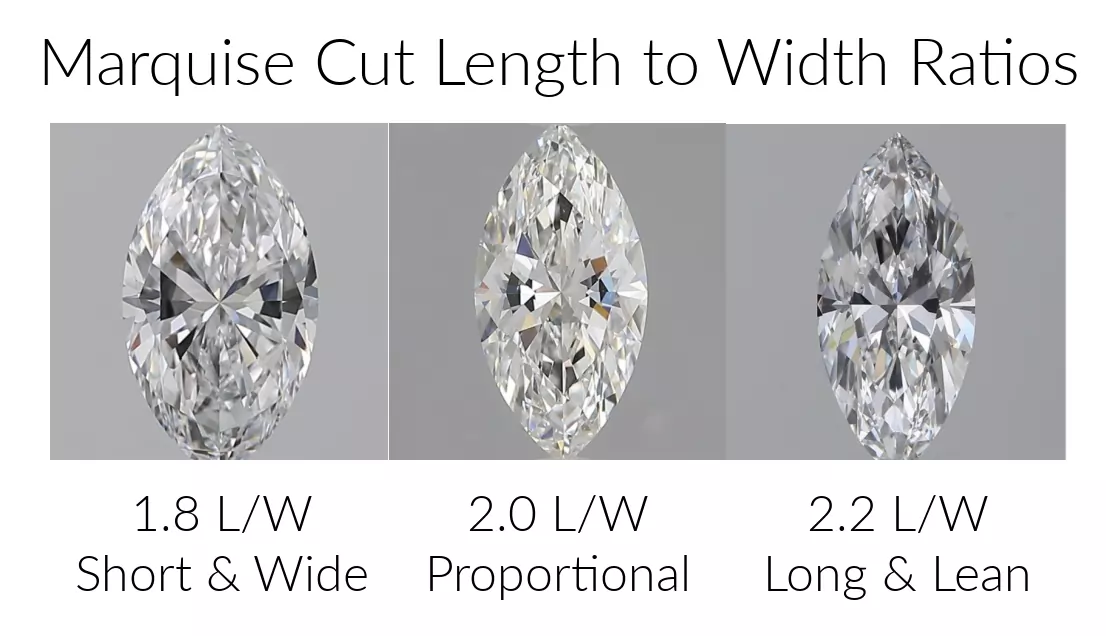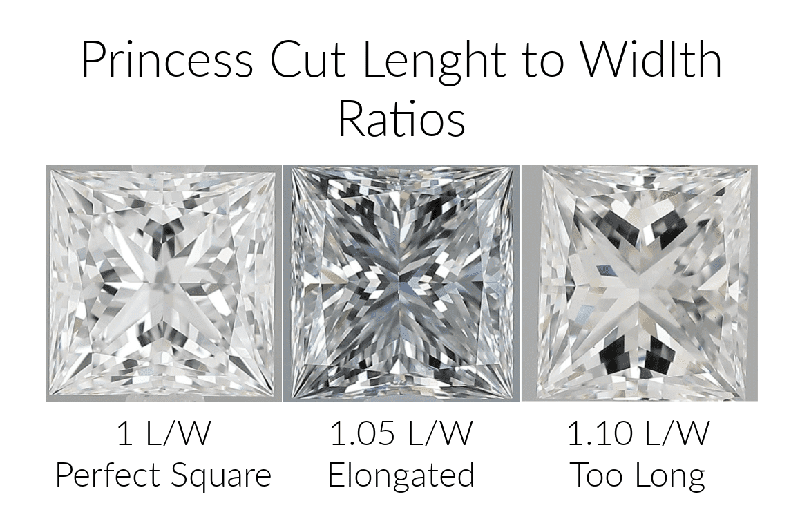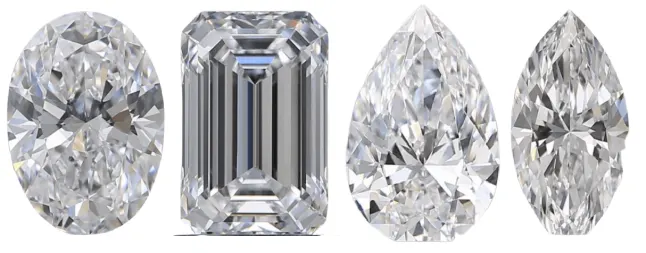- Length-to-width ratio determines a diamond's overall shape and look
- Ideal ratios vary by shape—e.g., round is 1.0, oval ranges from 1.3 to 1.5.
- A pleasing ratio ensures a well-proportioned and symmetrical appearance.
- The ratio affects how elongated or chunky a stone appears when worn.
- It’s especially important for fancy shapes like emerald, oval, and pear.
There are a ton of small details in life that we pretty much never think about…things like the type of grass under our feet, or if there are more nails or screws in the world - and not to mention a diamond’s proper length to width ratio. Even though minor stuff like this isn’t often on the mind, it can totally make a difference in the overall quality and/or experience. And, with our diamonds specifically, the length to width ratio can absolutely make or break the aesthetic appeal of the gem! I will explain a little more about what the diamond ratio concept is, which diamond shapes this applies to, and why it is so important to be aware of how a diamond is cut!
What is a Length to Width Diamond Ratio?
There are a few different cut characteristics (as in how the diamond was cut from start to finish) that indicate the overall quality of a diamond. But, when it comes to a diamond’s shape appeal specifically, the length to width ratio plays a big part. The ratio is technically a numerical expression of the length to width relationship in a particular diamond. Most diamond reports won’t necessarily give you the length to width ratio itself, but they do provide the official length, width, and depth measurements. Dividing the measured length by the measured width will give you the first number of the proportion (or “the length), with “the width” always being 1 in the final proportion of the ratio.
- For example: if the length of a stone is 6mm and the width is 3mm, we would take 6.00mm ÷ 3.00mm = 2mm so the final length to width ratio for this gem would be 2:1.
Now if you happen to be wondering "is possible to find out the length to width ratio of a diamond myself"...the answer is yes! But you will need a tiny measuring tape with millimeters easily accessible (and I would recommend a microscope for accuracy). If you are equipped with these items, then finding the diamond’s ratio is easy! Measure the length and the width of the gemstone and then follow the same mathematical equation as above.
Diamond Shapes
In the world of diamonds, the round brilliant cut reigns supreme. In fact, the standard cut grading scale (as in the 4 C’s)) is designed around this circular silhouetted stone. One of the cut quality factors that a round shaped diamond is not judged by though is the length to width ratio (since circles really shouldn’t be long or wide!). These measurements are reserved for our fancy cut diamonds instead.
A fancy cut diamond is essentially any diamond shape that is not a circle. The fancy shaped diamonds most affected by length to width ratios would be the emerald, oval, pear, marquise, princess, radiant and cushion cuts. Interestingly though, because some ratios look better than others, each of these diamond shapes has its own preferred proportions that work best for them.
Emerald
Traditionally, an emerald cut is a rectangular step-cut diamond. Sometimes you can find a square emerald cut, but they are not nearly as popular. While the length to width preference varies from person to person, typically the most sought after ratio is 1.40 - 1.50.

Oval
Oval shaped diamonds look best with a 1.30 - 1.50 length to width ratio. Typically, if you're outside of those ranges, you'll get more of the dreaded bow tie shadow in the center. This isn't always the case but is definitely more common.

Pear
The pear is another shape that can have a visible bow tie if the length to width is too short or long. Shoot for 1.45 - 1.55 to avoid this.

Marquise
Rounding out the shapes that can sometimes suffer from bow tie shadows is the marquise. This boat, football or smile shaped diamond looks best with a 1.80 - 2.20 length to width ratio.

Princess
Princess cut diamonds are meant to be square, so the closer to 1.0 you are for the L/W the better! I would suggest sticking with 1.0 - 1.03 to ensure it's nice and square anything above that and you're going to start noticing some elongation.

Radiant
The cousin to the emerald cut, this elongated brilliant cut diamond is usually elongated but you can sometimes find square radiants too! The further away from 1 you go for the l/w ratio, the more elongated the diamond is going to be. There really is no right or wrong answer here, just be sure to see an image or video of the diamond first to ensure there is no bow tie (yep, they can happen in radiants too).
Why is the Length to Width Diamond Ratio Important?
Aesthetic Appeal: There are a few reasons why the length to width ratio in diamonds is important - the most obvious one being the visual aspect (of course). When things, in general, are disproportionate, unbalanced, or asymmetrical, they can look strange…I mean imagine if one of my arms was two feet longer than the other! Even if something is just a little odd, we still tend to notice. This same concept also applies to diamonds. Proportions are surprisingly extremely important in the larger visual appeal of the stone. There might be something slightly off, even if you can’t pinpoint it, that gives the diamond an unusual appearance. Simply looking at the diamond first, inspecting for any kind of uneven or lop-sidedness, should help you avoid buying anything that will appear wonky!
Durability: Another significant aspect to think about when considering the length to width ratio in diamonds is their durability. Sure, diamonds might be the hardest substance on the planet but that means they are almost impossible to scratch (only diamond can scratch diamond). Chipping and/or breaking, however, is a very real possibility. For instance, long skinny stones with points (imagine a marquise)), that is not cut wide enough, could break off a point or even snap in half if accidentally hit on something hard enough.
Practicality: The last thought I would like to give on the importance of a diamond’s proper ratio is its practicality. There are fixed, calibrated sizes for diamonds that make the stones easy to match up or set into common mountings for jewelry. If the proportions are off then the diamond might require a custom mounting which can take more time, money, and effort to obtain. But, if you happen to already love an irregular-shaped diamond, this might be a great opportunity to design a piece of custom jewelry (which is always special).
Don’t worry guys! You may not have the official ratio numbers in front of you, or even the report with the exact millimeter measurements so you can mathematically figure it out but you do have your eyes! Look at the diamond and observe if the proportions appear to be off. See if the diamond tapers or narrows in the wrong places, or perhaps check if it widens or bulges on the sides weirdly…does the cut create an awkward-shaped stone?! Or If you are looking at the diamond and it looks pretty good, if it appears to be symmetrical and proportional and even, then your length to width ratio is most likely ideal for that stone! Just trust your eyes (and the innate diamond ratio intuition that I know you have) and you will be able to confidently pick out properly cut diamonds - and properly cut diamonds can ultimately indicate good quality stones!

